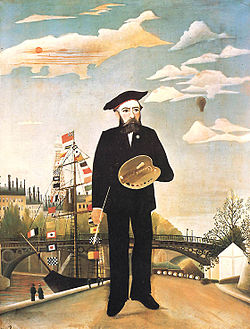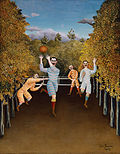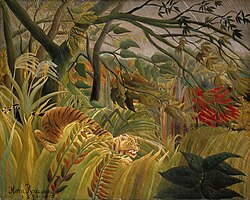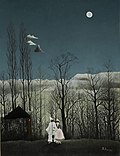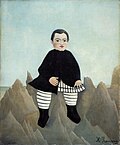Henri Rousseau
Henri Julien Félix Rousseau (French: [ɑ̃ʁi ʒyljɛ̃ feliks ʁuso]; 21 May 1844 – 2 September 1910)[1] was a post-Impressionist painter. He was born at Laval, Mayenne. He worked a variety of jobs (saxophonist, toll collector) before beginning to paint at age 40. He was known as Le Douanier ("the customs officer").
From 1886 onwards, he exhibited at the Salon des Indépendents. In 1905, he began exhibiting at the Salon d'Automne.
François Mathey wrote: "Rousseau is considered to be the greatest master of naïve painting, for his art combines a spontaneous vision of reality with an imaginary universe of great plastic and poetical power, in which he allied audacity with innocence, monumental composition with minute detail".[2]
Some critics ridiculed him for his style, but he came to be recognized as a self-taught genius.[3][4] Rousseau's work had a great influence on many avant-garde artists.[5]
He had an unhappy love affair in his last months. He died in Paris in 1910.[2]
He painted a few pictures of the Rainforests, and his pictures were very busy.some of His paintings are very famous around the world.
Legacy: The Flamingoes (painting) was sold for (c. $43 million, or) $43.5 million, in 2023.[6]
Gallery
Henri Rousseau Media
Tiger in a Tropical Storm (Surprised!) (1891) was the first of many jungle scenes for which Rousseau is best known.
A Carnival Evening, 1886, Philadelphia Museum of Art, Philadelphia, PA
Self Portrait, 1890, National Gallery Prague
Le Moulin (The Mill), c. 1896, Musée Maillol, Paris
Boy on the Rocks, 1895–1897, National Gallery of Art, Washington, D.C.
The Sleeping Gypsy, 1897, MoMA, New York
La tour Eiffel peinte par Henri Rousseau, 1898, Houston Museum of Fine Arts, Houston, Texas
References
- ↑ Henri Rousseau biography Archived 24 October 2008 at the Wayback Machine at the Guggenheim
- ↑ 2.0 2.1 Mathey, François 1965, The Museum of Impressionism in Paris, p66/7, Fernand Hazan
- ↑ Rousseau Archived 2009-05-06 at the Wayback Machine at the National Gallery of Art
- ↑ Stabenow, Cornelia (2001). Rousseau. Taschen. pp. 7, 8. ISBN 978-3-8228-1364-5.
- ↑ Smith, Roberta (2006) "Henri Rousseau: in imaginary jungles, a terrible beauty lurks" The New York Times, July 14, 2006. Accessed July 14, 2006
- ↑ https://www.nrk.no/kultur/xl/henri-rousseau-ble-hanet-og-ydmyket-av-kunstnere-og-kritikere-1.16892668. Retrieved 2024-06-02
